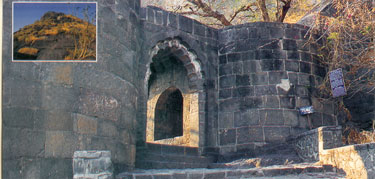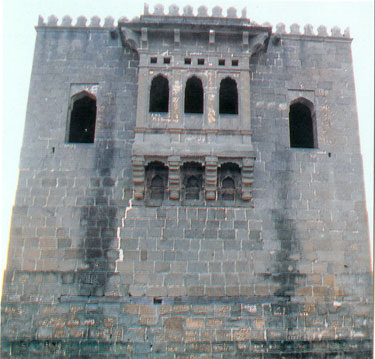 |
| Shivaneri Fort |
 |
Shivaneri hillfort, birth-place of Shivaji, is near Junnar town, about 85kms north of Pune. Situated on a 300 metre high isolated hill, the fort is triangular in shape. The wide base of the fort is towards the south and the narrow point is towards the north. The ascending path to the fort is defended by seven gates, the fifth one being armoured with anti-elephant spikes. The fort has several rock-hewn cisterns and ponds, of which two large ones are known as Ganga and Jumuna. Today, there are only a few structures remaining in the fort. At one end there is a ruined stable and at the other end a mosque of the Mughal period. The house where shivaji was born (in February, 1630 AD) has been recently restored and a temple with statues of Shivaji and Jijabai called Shivakunja, has also been built. Sir Richard Temple in his book Shivaji and the Rise Marathas’ wrote about Shivaneri: “You will see what a rugged precipitous place this is and what a fitting spot it was for a hero to be born in!” |
| The Shivaneri hill, on which the fort is built, has a long back to the Satavahanas. There remains of rock caves on all the three faces of Shivaneri, which show that it was a Buddhist centre during the first three centuries AD. After the Satavahanas, the Shivaneri for was occupied by the Shilaharas, the Yadavas, the Bahamanis and the Mughals. In 1599 AD the hill fort was granted to Shivaji’s grandfather, Maloji Bhosale and passed down to Shahaji. Though Shivaji was born here, he had to surrender the fort to the Mughals and could not take it back in his lifetime. |
| The Shivaneri cluster forts, comprising Harishchandragarh, Jumnar, Jivadhan, etc. was very important strategically, because it controlled the ancient Name Ghat Pass. |
 |
| Pictures:
One of the seven gates of the Shivaneri fort (above), and the central hilltop at the centre of the fort up (inset). The Kamani mosque in the fort (below, left), and the restored birth place of Shivaji (below, right) |
| |
|
|